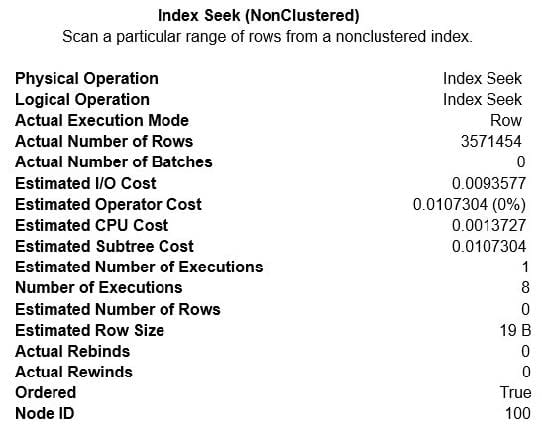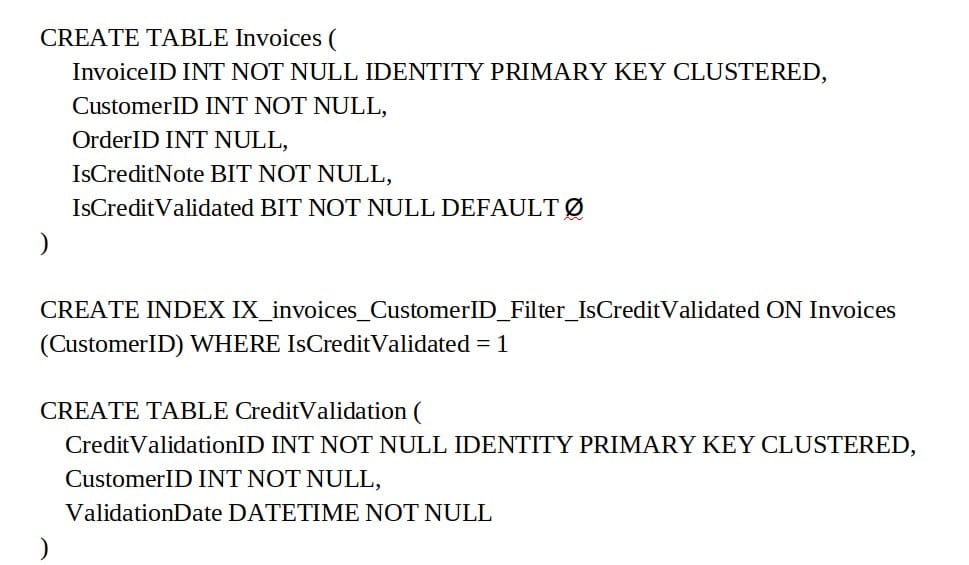70-762 Online Practice Questions and Answers
Note: The question is part of a series of questions that use the same or similar answer choices. An answer choice may be correct for more than one question in the series. Each question is independent of the other question in the series. Information and details provided in a question apply only to that question.
You have a database named DB1. The database does not have a memory optimized filegroup. You create a table by running the following Transact-SQL statement:

The table is currently used for OLTP workloads. The analytics user group needs to perform real-time operational analytics that scan most of the records in the table to aggregate on a number of columns. You need to add the most efficient index to support the analytics workload without changing the OLTP application.
What should you do?
A. Create a clustered indexon the table.
B. Create a nonclustered index on the table.
C. Create a nonclustered filtered index on the table.
D. Create a clustered columnstore index on the table.
E. Create a nonclustered columnstore index on the table.
F. Create a hash index on the table.
Note: This question is part of a series of questions that present the same scenario. Each question in this series contains a unique solution. Determine whether the solution meets the stated goals.
Your company has employees in different regions around the world.
You need to create a database table that stores the following employee attendance information:
-Employee ID
-
date and time employee checked in to work
-
date and time employee checked out of work
Date and time information must be time zone aware and must not store fractional seconds.
Solution: You run the following Transact-SQL statement:

Does the solution meet the goal?
A. Yes
B. No
Note: This question is part of a series of questions that present the same scenario. Each question in this series contains a unique solution. Determine whether the solution meets the stated goals.
Your company has employees in different regions around the world. You need to create a database table that stores the following employee attendance information: Employee ID date and time employee checked in to work date and time employee checked out of work
Date and time information must be time zone aware and must not store fractional seconds.
Solution: You run the following Transact-SQL statement:

Does the solution meet the goal?
A. Yes
B. No
Note: This question is part of a series of questions that present the same scenario. Each question in the series contains a unique solution. Determine whether the solution meets the stated goals. You have a table that has a clustered index and a nonclustered index. The indexes use different columns from the table. You have a query named Query1 that uses the nonclustered index. Users report that Query1 takes a long time to report results. You run Query1 and review the following statistics for an index seek operation:

You need to resolve the performance issue. Solution: You defragment both indexes. Does the solution meet the goal?
A. Yes
B. No
You have a reporting application that uses a table named Table1. You deploy a new batch update process to perform updates to Table1.
The environment is configured with the following properties:
The database is configured with the default isolation setting.
The application and process use the default transaction handling.
You observe the application cannot access any rows that are in use by the process.
You have the following requirements:
Ensure the application is not blocked by the process.
Ensure the application has a consistent view of the data
Ensure the application does not read dirty data.
You need to resolve the issue and meet the requirements with the least amount of administrative effort.
What should you do?
A. Enable the database for the ALLOW_SNAPSHOT_ISOLATION isolation level. Modify the application for the SERIALIZABLE isolation level.
B. Enable the database for the READ_COMITTED_SNAPSHOT isolation level.
C. Enable the application for the WITH (NOLOCK) hint.
D. Enable the database for the ALLOW_SNAPSHOT_ISOLATION isolation level. Modify the application and the update process for the SNAPSHOT isolation level.
You are creating the following two stored procedures: A natively-compiled stored procedure An interpreted stored procedure that accesses both disk-based and memory-optimized tables
Both stored procedures run within transactions.
You need to ensure that cross-container transactions are possible.
Which setting or option should you use?
A. the SET TRANSACTION_READ_COMMITTED isolation level for the connection
B. the SERIALIZABLE table hint on disk-based tables
C. the SET MEMORY_OPTIMIZED_ELEVATE_TO_SNAPSHOT=ON option for the database
D. the SET MEMORY_OPTIMIZED_ELEVATE_TO_SNAPSHOT=OFF option for the database
You use Microsoft SQL Server Profile to evaluate a query named Query1. The Profiler report indicates the following issues:
At each level of the query plan, a low total number of rows are processed.
The query uses many operations. This results in a high overall cost for the query.
You need to identify the information that will be useful for the optimizer.
What should you do?
A. Start a SQL Server Profiler trace for the event class Performance statistics in the Performance event category.
B. Create one Extended Events session with the sqlserver.missing_column_statistics event added.
C. Start a SQL Server Profiler trace for the event class Soft Warnings in the Errors and Warnings event category.
D. Create one Extended Events session with the sqlserver.error_reported event added.
You are optimizing the performance of a batch update process. You have tables and indexes that were created by running the following Transact-SQL statements:

The following query runs nightly to update the isCreditValidated field:

You review the database and make the following observations:
Most of the IsCreditValidated values in the Invoices table are set to a value of 1.
There are many unique InvoiceDate values.
The CreditValidation table does not have an index.
Statistics for the index IX_invoices_CustomerID_Filter_IsCreditValidated indicate there are no individual seeks but multiple individual updates.
You need to ensure that any indexes added can be used by the update query. If the IX_invoices_CustomerId_Filter_IsCreditValidated index cannot be used by the query, it must be removed. Otherwise, the query must be modified to use with
the index.
Which three actions should you perform? Each correct answer presents part of the solution.
NOTE: Each correct selection is worth one point.
A. Add a filtered nonclustered index to Invoices on InvoiceDate that selects where IsCreditNote= 1 and IsCreditValidated = 0.
B. Rewrite the update query so that the condition for IsCreditValidated = 0 precedes the condition for IsCreditNote = 1.
C. Create a nonclustered index for invoices in IsCreditValidated, InvoiceDate with an include statement using IsCreditNote and CustomerID.
D. Add a nonclustered index for CreditValidation on CustomerID.
E. Drop the IX_invoices_CustomerId_Filter_IsCreditValidatedIndex.
You have a view that includes an aggregate.
You must be able to change the values of columns in the view. The changes must be reflected in the tables that the view uses.
You need to ensure that you can update the view.
What should you create?
A. a DML trigger
B. a schema-bound view
C. a stored procedure
D. a DDL trigger
Note: This question is part of a series of questions that present the same scenario. Each question in the series contains a unique solution. Determine whether the solution meets the stated goals.
You need to identify the indexes that are not being used so that you can remove them from the database.
Solution: You run the sys.dm_db_index_physical_stats dynamic management view.
Does the solution meet the goal?
A. Yes
B. No

